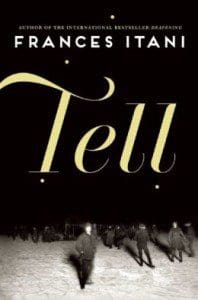 Exploring the emotional gaps created by grief and prolonged silence, Frances Itani’s new novel, Tell (Black Cat Press; 318 pages), is the story of a Canadian family coping with the fallout of the First World War. Picking up the thread from Itani’s 2003 novel, Deafening, Tell weaves an intricate narrative of two couples struggling with things left unsaid. The novel opens in 1921 before flashing back in time, with the bulk of the story occurring in the last two months of 1919.
Exploring the emotional gaps created by grief and prolonged silence, Frances Itani’s new novel, Tell (Black Cat Press; 318 pages), is the story of a Canadian family coping with the fallout of the First World War. Picking up the thread from Itani’s 2003 novel, Deafening, Tell weaves an intricate narrative of two couples struggling with things left unsaid. The novel opens in 1921 before flashing back in time, with the bulk of the story occurring in the last two months of 1919.
Tress and Kenan are a young couple trying to reconnect after Kenan’s return from the front; meanwhile, Am and Maggie, Tress’s middle-aged aunt and uncle, are in a marriage that betrays a fragility neither will acknowledge. Itani expertly portrays the intricacies of each character, revealing the similarities among them slowly and deliberately. Despite the tensions in the novel’s romantic relationships, the connections between the two couples are both affectionate and complex. Seeing themselves reflected in their younger counterparts, Maggie and Am offer guidance and advice, hoping to help a marriage affected by Kenan’s wartime injuries.
Am recognizes Kenan’s struggles even when the young man is unable to fully grasp them, while Maggie seems almost instinctively in tune with Tress’s growing sadness and uncertainty. “‘Am and I are twice your age,’” Maggie tells Tress, “‘and there have been times when we’ve reached a blind or standstill in our marriage, and wondered how we got there. You two are young, you’re obliged to—you have to—fix the problem. You owe that to each other.’” The parallel between the two couples is built on repetition, the similarities of their lives coming into sharper focus with the revelation of each shared experience and emotion.
Tell is structured around introspection and the shifting perspective among the four protagonists, but focuses mainly on Kenan, Maggie, and Am. Despite its long silences, the novel’s most significant moments are captured through conversation—in the telling of insights that result from contemplation. When these moments do surface, they are powerful (sometimes explosive), accelerating the story with something approaching inevitability.
Powerful conversations are balanced with deft portrayals of grief and pain, sentiments made palatable by Itani’s thoughtful prose. Through reflection, she creates a space where the characters can consider the difficult moments of their lives, layering the narratives on top of each other, allowing the sadness of those moments to permeate the entire story. “How do we learn to love and hate? How do we learn to grieve and mourn?” Kenan wonders, considering his journey in tandem with Am’s.
Unsettling but never hopeless, Tell thoughtfully acknowledges a sad reality: “‘After you’ve bottled up the words long enough, they get sealed off so tightly you don’t say them anymore.’” Yet Itani’s novel rails against the circumstances that prevent such revelation. It is an invitation to speak, share and commiserate—an invocation to tell those things that seem forbidden and foregone.
